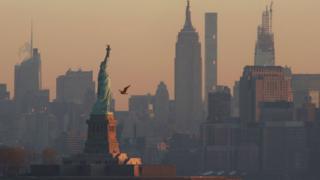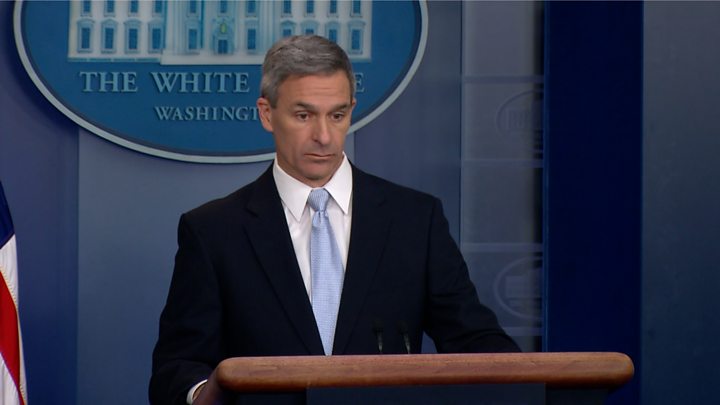Trump’s ‘wealth test’ begins for US immigrants
A controversial new policy that denies legal residency to migrants who have received government assistance has come into effect in the US.
The policy, termed the “public charge rule” by proponents and a “wealth test” by critics, was cleared by the Supreme Court last week.
It means that many legal immigrants who previously had qualified for residency no longer would, studies show.
Republicans and President Donald Trump argue the rule protects US taxpayers.
What’s changed?
The policy, which was first announced in August but delayed until now by federal courts, adds restrictions to the “public charge” rule that immigration agents consult when considering individual cases for green cards, which grant permanent US residency.
The vaguely-defined public charge rule has been in place for over 100 years, and says that migrants who are likely to require extensive government welfare should not be admitted.
But under the new rules, some recipients of “non-cash” benefits including particular types of healthcare assistance, food aid and housing subsidies can also be turned down – on the basis that they are “a public charge”.
The update also raises the salary required for a family of four from $32,000 (£25,000) per year to $60,000 (£46,000).
The policy applies to anyone who received government welfare for 12 months at any point in the past 36 months.
The rule does not apply to refugees, asylum-seekers, or victims of crimes who are aiding US investigators.
It also exempts certain benefits from consideration by immigration agents – including emergency medical assistance, school lunch subsidies, disaster relief and government healthcare (Medicaid) for those under 21 years old.
Nonetheless, almost two-thirds of migrants who qualified for legal US residency between 2012 to 2016, would not have done if these rules had been in place then, according to a study by the Washington-based Migration Policy Institute.
The new policy will not apply to anyone who had applied for residency prior to 24 February.
What do critics say?
Democrats and civil rights activists have condemned the change, pointing out that recipients of government aid tend to be people from vulnerable populations such as women, children, and the elderly.
The National Immigration Law Centre, a think-tank, attacked it as a “morally repugnant and legally dubious regulation”.
The group said that nearly millions of non-citizens in the US are receiving the newly-disqualifying public services.
Democrats warn that as of Monday, when the public charge law took effect, it will be more likely that low-income immigrants will face deportation.
What does the White House say?
White House press secretary Stephanie Grisham praised the new rule after the Supreme Court on Friday lifted injunctions that kept it from taking effect.
“This final rule will protect hardworking American taxpayers, safeguard welfare programmes for truly needy Americans, reduce the Federal deficit, and re-establish the fundamental legal principle that newcomers to our society should be financially self-reliant and not dependent on the largess of United States taxpayers,” she said.
Acting Deputy Secretary of Homeland Security Ken Cuccinelli, who pushed through the rule change during his time with US Citizenship and Immigration Services, said it was intended by Mr Trump “to make self-sufficiency matter again in a meaningful way”.
“It’s just plain old logic – what country wants to bring welfare problems into its society? We don’t want to do that,” he told Fox News.
What’s the latest on the travel ban?
Also on Monday, six more countries were added to the White House travel ban – bringing the number of countries affected to 13.
Nigeria, Myanmar, Eritrea, Kyrgyzstan, Sudan and Tanzania are joining Iran, Syria, Yemen, Libya, Somalia, North Korea and Venezuela.
The ban – which has been argued over in courts for years – prohibits anyone from those countries from seeking immigrant or non-immigrant visas, though some exemptions are made for people who have “significant contacts” in the US.
What’s the bigger picture?
The new rules come as Mr Trump seeks to tout his record on immigration heading into his 2020 re-election campaign.
Since 2016, Mr Trump has sought to curtail both legal and illegal immigration through a variety of actions including efforts to construct a US southern border wall, and requiring US asylum seekers to wait in Mexico to have their cases heard.
Last November, Mr Trump slashed the number of refugees the US would allow in to 18,000.
In 2016 – the final full year of former President Barack Obama’s second term – the refugee ceiling was set at 110,000.
Source: Read Full Article




